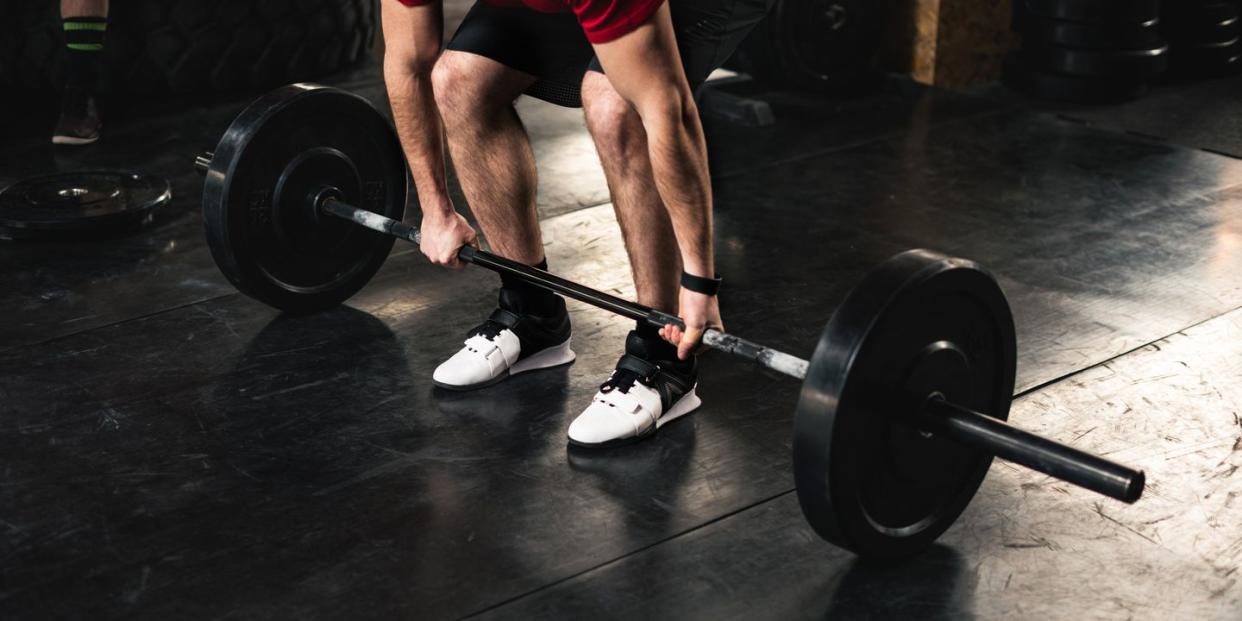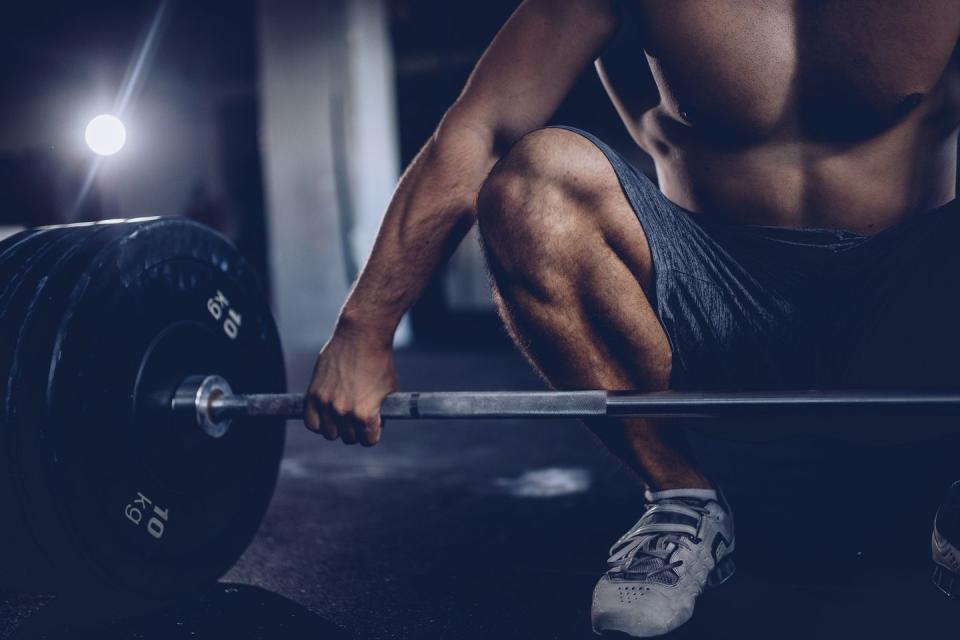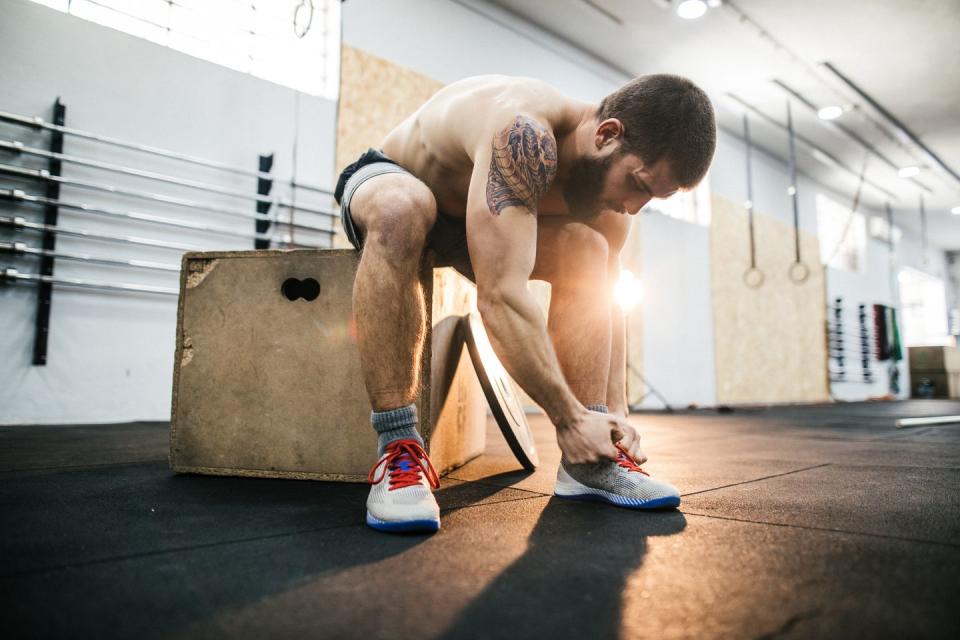The Best Shoes to Wear for Lifting, According to Trainers

Having the right shoes for weightlifting is anything but an aesthetic choice. Picking the appropriate style for your training type and particular emphases are key for improving your lifting performance and helping you set new PRs.
"Weightlifting shoes are important for generating more force on heavy moves such as deadlifts, lunges, and squats. The goal is to have the shoe help you generate more force through a harder sole surface with manual cushioning," says Ridge Davis, CPT, owner of Ridgid Fitness in Los Angeles. "They also provide ankle stability so the knees and hips don’t compensate. General exercise shoes and running shoes tend to have too much cushion and absorb a fair amount of force needed for weightlifting."
The right weightlifting shoes are also going to protect your joints.
"They help elevate the heel of the athlete to get more safe and efficient joint angles for loading in the various training movements," says Albert Matheny, C.S.C.S., Chief Operating Officer at ARENA Innovation Corp. "A non-stable base will travel up the chain and may result in ankle, knee, shoulder, wrist, etc.-type injury because of a slip in the base that requires an adjustment up the chain that the body is not prepared for. A very small change can lead to a serious injury under load."
Ultimately, weightlifting shoes will improve your lifting performance.
And science backs it up. One 2012 study found that when lifters performed a one rep max barbell back squat, they were more likely to maintain proper form and reduce lower back strain while wearing weightlifting shoes versus basketball sneakers. Another more recent study similarly found that compared to more general athletic shoes, weightlifting shoes reduced ankle movement and helped lifters maintain an upright torso during squats.
How to Pick Your Lifting Shoes

There are a few things to keep in mind when it comes to picking the right weightlifting shoe for you. “You are going to need a shoe that has a hard sole, an elevated heel, and some lateral support,” says Sean Waxman, CSCS, head coach and owner of Waxman’s Gym.
The right shoe will help you generate as much force through the floor as possible in order to pick up heavy weights.
“The hard, flat sole in weightlifting shoes allows more force to be applied into the ground,” says Scott Caulfield, C.S.C.S., the head strength and conditioning coach at the National Strength and Conditioning Association. “You wouldn't want to use a real big air cushion sneaker to lift in, because that cushioning is going to just dissipate force and be like a big sponge on the foot and on the floor.”
No matter what discipline you practice, you want the sole to be hard and flat. An elevated heel helps the natural movement of your body and your torso stay upright during a snatch or clean-and-jerk. “The heel lift gives you a little bit more mobility in your ankle,” Caulfield says. “By raising your heel, it allows you to get into your lower squat position, and also allows you to maintain an upright posture easier, because what happens if you lean too far forward, the biomechanics of that bar being out over you can put you in a bad position.”
Adds Matheny, "If the joint angle is not optimal due to a limited range of motion by the lifter, the can cause stress/imbalance of loading at the knees, back, shoulder, wrist, etc."
But for squatting, deadlifting, and bench pressing at maximum volume, you'll probably want to skip the heel. “If you're going to squat wide stance, you don't want a heel,” says Jordan Syatt, owner of Syatt Fitness and five-time powerlifting record-holder. “You should have a flat shoe.” The heel does not serve you well in a wide stance because it stops mimicking your body’s natural position as you do a squat. And in a deadlift, Waxman says, you need to have your weight back towards the heel—so an elevated heel is no good. That’s why many powerlifters demand a more minimalist shoe with a flat sole (if they're not lifting barefoot).

CrossFit adds another complexity to the lifter’s shoe dilemma. “In a workout where you might be doing more than just lifting, you’ll want something multifunctional,” says Caulfield. “If your workout is going to involve jumping on boxes, or shuffling, or doing any sort of agility, you want to have a shoe that can take on that.” That means CrossFit shoes have the flat sole of most lifting shoes, but with added flexibility in the toe and sole that allows for more movement. Some even come with extra traction for rope climbs.
Here are 9 of the best weightlifting shoes, according to trainers.
Converse Chuck Taylor All Stars
Some of our experts disagreed on various points—but no one chose anything other than the classic Converse Chucks to meet your powerlifting needs. “From a powerlifting standpoint, they're pretty much standard,” Caulfield says.
Chucks have the necessary hard, flat rubber sole that you require for your strongest lifts, as well as some ankle support when you get the high-tops. For wide-stance squats (where you don’t want a heel but need to be close to the floor), deadlifts, and bench press, Chuck Taylors have remained the king for decades. “I got Chuck Taylors as my first lifting shoe when I was like 18, and I loved them,” Syatt says.
Adds Davis, "The hard rubber soles make it my favorite shoe on heavy days for squats and deadlifts. They’re essentially the classic powerlifting shoe and it’s probably going to stay that way."
Reebok Nano X1
"These are great lightweight material shoes with a softer cushion," says Davis. "This shoes is great for more agile and dynamic weightlifting because of the combo of soft cushioning and stable ankle support."
Do-Win Weightlifting Shoes
Matheny is a big fan of Rogue Fitness, and likes these Do-Wins that are sold on the site. "If you can't find the right fit with the other brands, give them a try."
Nike Metcon 6
The best all-around CrossFit shoes should have tons of dynamism to them—for lifting, running, box jumps, or whatever your WOD may contain. “It's flat, and it's very sticky on the bottom, which is perfect,” Syatt says. “And it's also very athletic.”
Adds Davis, "These are such a dynamic shoe for all facets of training, but especially weightlifting. I love how lightweight the shoe feels and the breathable material for my feet. Also the shoe functions great for the heavy lifts in all planes of motion because of its great traction and foot support."
Reebok Legacy Lifter II
"The Reebok Legacy Lifter II has a lower heel, which makes it more versatile if you are not just lifting in the shoes because they are a bit more flexible," says Matheny. "They are also good for wider feet."
APL Techloom Tracer
"This shoe has the best foot support and ankle stability," says Davis. "The technology of the shoe uses anti-stretch materials to keep your foot centered on the shoe and ultimate stability."
Adidas Powerlift 4
"I personally enjoy the fit of Adidas shoes," says Matheny. "They have a wide, stable base and good heel lift."
PUMA Fuse Training Shoe
"These shoes have a strong, stable base that is perfect for heavy lifts such a squats, deadlifts, and lunges," says Davis. "It has phenomenal grip and support for being able to move in all directions with freedom and power."
Nike Romaleos 4
"These Romaleos are very supportive if you like the fit of Nikes for your other shoes as well," says Matheny.
You Might Also Like

